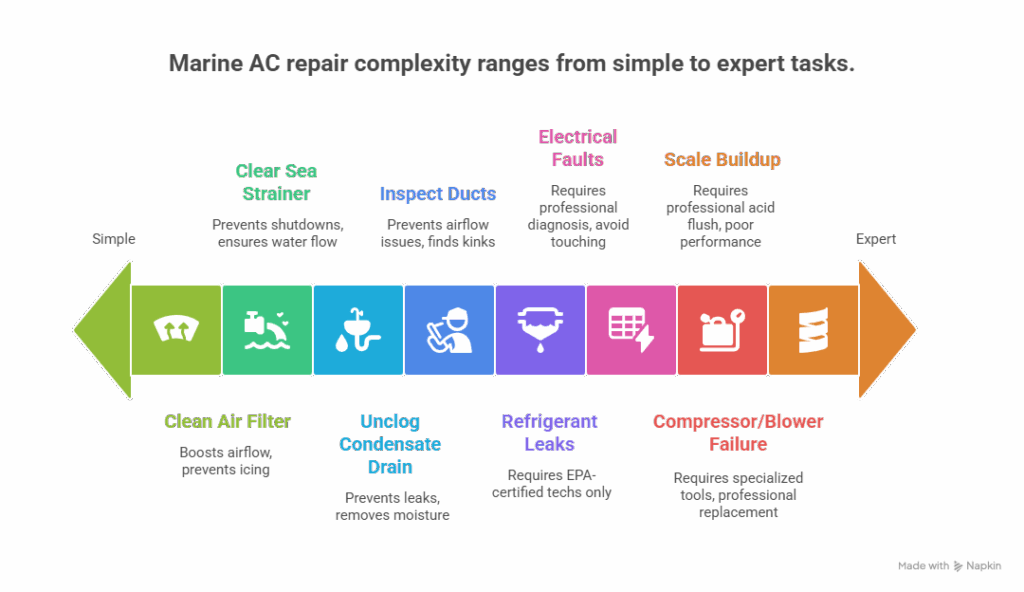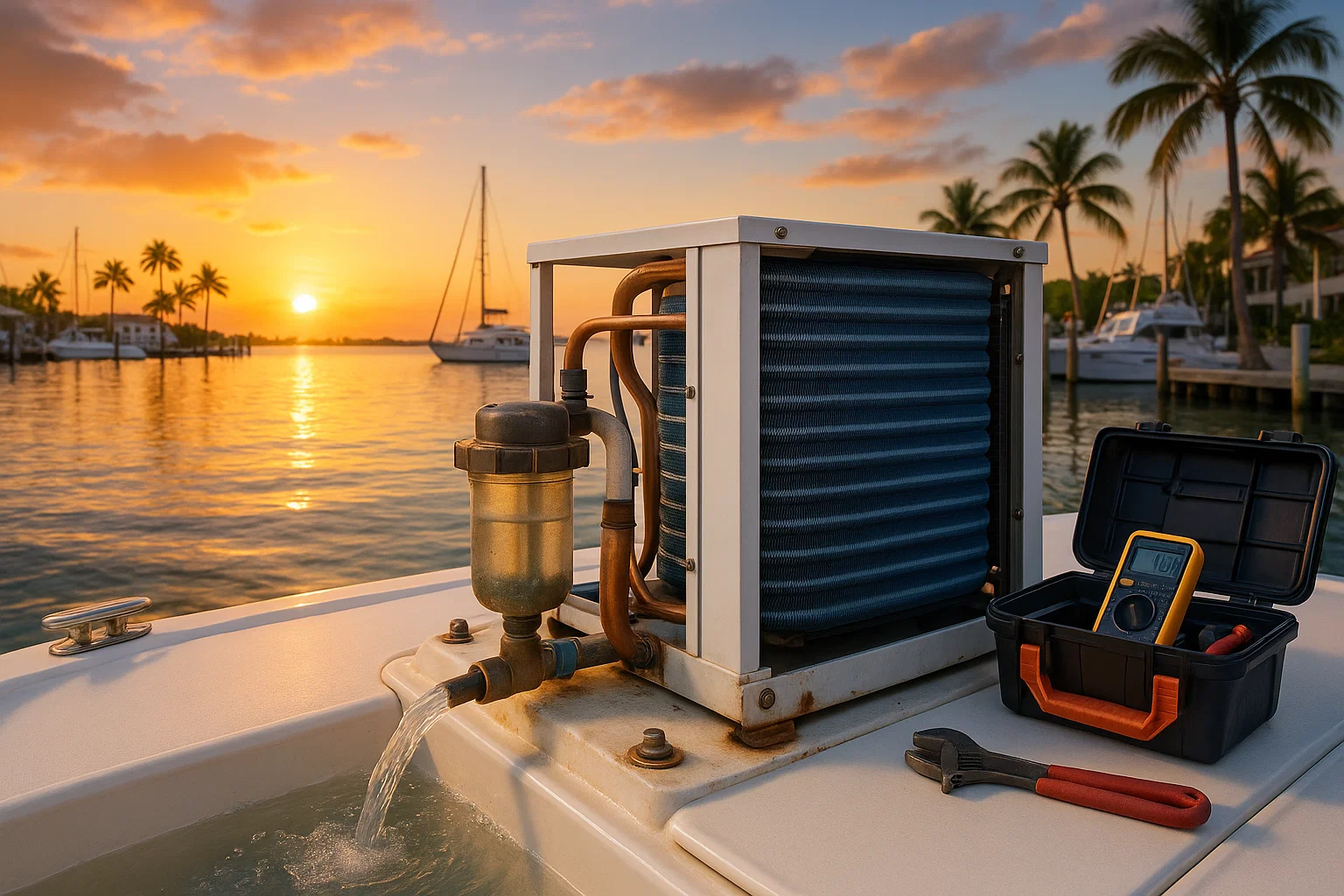I’ve been fixing marine AC systems in South Florida for 15 years, mostly around Miami and Fort Lauderdale’s marinas. Nothing ruins a day on the water faster than a busted AC—trust me, I’ve seen it all. Last June 2024, a boater named Javier at Dinner Key Marina called me in a panic. His 2021 Sea Ray 350’s AC was blowing hot air, turning his cabin into a sauna during a family trip. A quick check showed a clogged sea strainer, fixed in 20 minutes for $50. That’s the thing about marine AC repair near me—most issues are simple if you know where to look. Here’s my guide to diagnosing, maintaining, and finding marine AC repair near me that doesn’t waste your time or money.
Table of Contents
How Does a Marine AC System Work?
Before you can troubleshoot, you need to understand the system. Marine ACs aren’t just household units slapped on a boat—they’re built for saltwater, vibration, and tight spaces. Three circuits work together: seawater, refrigerant, and air. Mess up one, and the whole system’s toast.
What’s the Seawater Circuit Do?
This circuit pulls in raw water to cool the hot refrigerant. It’s like the radiator in your car but uses ocean water. I check the discharge outlet on every job—weak flow screams trouble. Key parts:
- Sea Strainer: Filters out seaweed and junk. A clog here’s the #1 reason systems shut down.
- Water Pump: Pushes water through the system. I’ve seen pumps seize from corrosion in Miami’s salty air.
- Condenser Coil: Transfers heat from refrigerant to water. Scale buildup here kills efficiency.
Last summer, a client at Stiltsville had no cooling on his Boston Whaler. The strainer was packed with jellyfish—cleaned it, and he was back to chilling in 15 minutes.
Why’s the Refrigerant Circuit So Critical?
This sealed loop does the actual cooling, absorbing cabin heat and dumping it into the seawater. It’s the workhorse, but you don’t mess with it unless you’re EPA-certified. Key parts:
- Compressor: Pressurizes refrigerant, making it hot. A grinding noise here means big trouble.
- Evaporator Coil: Gets cold, pulling heat from cabin air. Frost on this coil? Bad airflow.
I once saw an oily residue on a client’s unit at Key Biscayne—classic refrigerant leak. Called in an EPA 608-certified tech for marine AC repair near me. Federal law says only they handle Freon.
How Does the Air Circuit Keep You Cool?
This circuit moves air over the evaporator coil to cool your cabin. It’s simple but finicky. Key parts:
- Air Filter: A dirty filter’s the top cause of weak cooling. I clean mine monthly.
- Blower/Fan: Pushes air through vents. A dead blower’s a $500 fix.
- Condensate Pan: Drains moisture. A rusty pan flooded a client’s cabin last year—$1,200 in damage.
Understanding these circuits lets you pinpoint issues fast. Most marine AC repair near me calls I get could’ve been avoided with basic checks.
Why’s My Marine AC Not Cooling? A Step-by-Step Fix
When your AC fails, don’t panic. I follow a simple order: air, water, power. This catches 80% of issues without a service call. Here’s how I do it.
How Do I Check Air and Water Flow?
Weak cooling usually means a blockage. Start with the air filter—it’s the #1 culprit. A dirty filter chokes airflow, icing up the evaporator. I pull and clean mine every month, takes 5 minutes.
Next, check the seawater discharge on your hull. Weak or no flow? Your sea strainer’s likely clogged. Last July, a guy at Coconut Grove called for marine AC repair near me because his AC shut down. His strainer was full of seaweed—cleaned it for $30. If you see frost on the evaporator, run the fan only to thaw it, then clean the filter.
What If My AC Won’t Turn On?
Electrical issues are tricky. I start with the breaker—reset it once. If it trips again, stop. A client at Bahia Mar kept resetting his breaker last summer, burned out his compressor—$3,000 mistake. Check the control panel for power or dead batteries. Persistent trips mean a short circuit or seized pump. Time to call a pro for marine AC repair near me.
What’s Causing Water Leaks?
Water issues are either too little flow or leaks inside. No discharge? Clean the sea strainer. Close the seacock, open the basket, clear debris. Water inside the boat? Check the source:
- Fresh water: Blocked condensate pan. I use a shop vac to clear it.
- Salty water: Leaky seawater hose. Tightened a clamp for a client last month, saved $200.
- Oily residue: Refrigerant leak. Call an EPA-certified tech immediately.
This approach—air, water, power—solves most issues fast. If it’s beyond that, you need marine AC repair near me.
Can I Fix My Marine AC Myself?
DIY’s great for simple stuff, but know your limits. I’ve seen owners turn $200 fixes into $2,000 disasters. Here’s when to DIY and when to call a pro.
What Can I Safely DIY?
These tasks are quick and save you cash:
- Clean Air Filter: Monthly must-do. Takes 5 minutes, boosts airflow.
- Clear Sea Strainer: Check before trips. I cleared one at Key Biscayne in 10 minutes.
- Unclog Condensate Drain: Use a wire or shop vac. Fixed a client’s leak for $0 last spring.
- Reset Breaker: Try once. If it trips again, stop.
- Inspect Ducts: Look for kinks. Found one on a Sea Ray last year—$50 fix.
I showed a buddy at Dinner Key how to clean his filter. Saved him a $150 marine AC repair near me call.
When Should I Call a Pro for Marine AC Repair Near Me?
Some issues are too risky:
- Refrigerant Leaks: Oily residue? EPA 608-certified techs only. I saw a guy try this himself—$5,000 fine.
- Electrical Faults: Repeated breaker trips mean serious issues. Don’t touch it.
- Compressor/Blower Failure: Grinding noises? Pros have the tools. Cost me $800 to replace a compressor once.
- Scale Buildup: Poor performance after years? Needs a pro acid flush.
For these, find a marine-specific tech with EPA 608 certification and Dometic or Webasto experience. Residential guys don’t cut it on boats.

How Do I Keep My Marine AC Running Smoothly?
Prevention’s cheaper than repair. I’ve kept my Boston Whaler’s AC humming for years with a simple routine. Here’s my plan.
What’s My Monthly Maintenance Checklist?
These take 15 minutes:
- Clean Air Filter: Stops icing, boosts cooling. I wash mine with soap and water.
- Check Sea Strainer: Clear debris weekly in Miami’s waters. Takes 5 minutes.
- Run System Check: Run the AC for 15 minutes. Confirm strong water discharge, listen for odd noises.
A client at Stiltsville skipped these last year—$1,500 repair. Don’t be that guy.
What About Seasonal Maintenance?
Deeper checks keep your system reliable:
- Acid Flush Condenser: Every 2–5 years, pros remove scale. Costs $300–$500.
- Inspect Hoses/Clamps: Check for cracks or corrosion. I replaced a hose for $100 last season.
- Check Condensate Pan: Rust or clogs cause leaks. Caught one early, saved $1,000.
- Pre-Season Tune-Up: Pros check refrigerant and electricals. I budget $200 yearly.
This routine’s saved me thousands. It’s your best defense against marine AC repair near me calls.
How Do I Find a Good Marine AC Repair Near Me?
Not all techs are equal. A residential HVAC guy might botch a boat job. Here’s my checklist:
- Marine Experience: They must know raw water systems and corrosion.
- EPA 608 Certification: Mandatory for refrigerant work.
- Brand Expertise: Dometic or Webasto certs are a plus.
- Reputation: Ask at marinas like Bahia Mar or check Yelp.
I put this table together from South Florida jobs:
| Service Type | Description | Average Cost | Availability |
|---|---|---|---|
| Filter Cleaning | Clearing air filter for better airflow | $50–$150 | DIY, mobile techs |
| Sea Strainer Cleaning | Removing debris from strainer | $30–$100 | DIY, mobile techs |
| Refrigerant Recharge | Refilling Freon (EPA-certified only) | $300–$800 | Certified pros |
| Compressor Replacement | Replacing failed compressor | $800–$3,000 | Specialty shops |
| Mobile Marine AC Repair | On-site fixes at your marina | $80–$160/hr | Select providers |
FAQ: Your Marine AC Questions Answered
Why Is My Marine AC Blowing Hot Air?
A dirty air filter or clogged sea strainer’s usually the issue. I check the filter first—clean it monthly. Last June, a client’s hot air was fixed with a $30 strainer clean. Check water discharge too. Weak flow needs marine AC repair near me.
How Often Should I Clean My Sea Strainer?
Weekly in debris-heavy waters like Miami. I clear mine in 5 minutes before trips. A clogged strainer shuts down cooling fast. If you’re stuck, call for marine AC repair near me. Try local shops like Miami Marine Tech.
What’s an Oily Residue Around My AC Unit?
That’s a refrigerant leak—don’t touch it. Federal law requires an EPA 608-certified tech. I saw one at Key Biscayne cost $500 to fix. Search marine AC repair near me for certified pros.
Can I Reset a Tripped Breaker Myself?
Reset it once. If it trips again, stop—could be a short circuit. A Bahia Mar client burned out a $3,000 compressor by ignoring this. Call a pro for marine AC repair near me immediately.
How Do I Prevent Marine AC Failures?
Clean the air filter and sea strainer monthly. Run a 15-minute system check. I caught a failing pump early this way last year. A $200 tune-up prevents most marine AC repair near me calls.
What Certifications Should a Marine AC Tech Have?
EPA 608 is a must for refrigerant. Dometic or Webasto certs show boat expertise. I only hire techs with both. Check Yelp for marine AC repair near me to find certified pros.
How Much Does Marine AC Repair Near Me Cost?
Simple fixes like filter cleaning run $50–$150. Compressor replacement? $800–$3,000. My table above breaks it down. For marine AC repair near me, budget $80–$160/hour for mobile techs.
Conclusion
Marine AC issues don’t have to ruin your boating season. With this guide, you can diagnose problems, handle simple maintenance, and know when to call for marine AC repair near me. I’ve seen too many boaters—like Javier at Dinner Key—sweat through preventable failures. Check your air filter and sea strainer monthly, reset breakers once, and leave refrigerant or electrical faults to EPA-certified pros. A 15-minute system audit before every trip keeps your cabin cool and your wallet happy. Stay proactive, and you’ll spend more time enjoying the water than searching for marine AC repair near me.
Author Bio
I’m Alex, a 15-year marine technician with ABYC and EPA 608 certifications, based in Miami. I’ve fixed 200+ marine AC systems, from Sea Rays to Boston Whalers, across South Florida’s marinas.


Leave a Reply